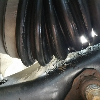jd4242
Explorer Addict
- Joined
- October 15, 2008
- Messages
- 10,790
- Reaction score
- 312
- City, State
- va beach
- Year, Model & Trim Level
- 92explorer&94 ranger
Anyone know how the fuel pump is wired?? Without getting into to much details on what im doing,im just looking for a schematic..
im basically trying to wire a relay to power my BIG pump and need to find a signal wire to turn the relay on..
Ive tested the relay under the hood and doesnt seem to ever go full 12v..it has 4 pins..pin 30 is always hot..87 is 7v**(i assume this is the wire that feeds the pump but never goes to 12v)**..85 is ground..86 is key on constant 12v..also if you trip the inertia switch none of these change..
The wire that runs to the pump(red with black strip) goes to 12v for 1 second then down to 7v when you turn the key on..it never goes to 0v...i know its only spose to prime the system but why doesnt it never go to 0 volts..this wire does go to 0v if inertia switch is tripped...
Without the wire going to 0v it keeps my relay and timers on...my pump does not have a check valve so had to put a timer on it to keep it priming till you start the truck....i want it to be able to trip or kick off in a accident so need to find a signal wire that goes to 0v after after key on prime or a constant 12v till the inertia switch is tripped and not use a timer..
im basically trying to wire a relay to power my BIG pump and need to find a signal wire to turn the relay on..
Ive tested the relay under the hood and doesnt seem to ever go full 12v..it has 4 pins..pin 30 is always hot..87 is 7v**(i assume this is the wire that feeds the pump but never goes to 12v)**..85 is ground..86 is key on constant 12v..also if you trip the inertia switch none of these change..
The wire that runs to the pump(red with black strip) goes to 12v for 1 second then down to 7v when you turn the key on..it never goes to 0v...i know its only spose to prime the system but why doesnt it never go to 0 volts..this wire does go to 0v if inertia switch is tripped...
Without the wire going to 0v it keeps my relay and timers on...my pump does not have a check valve so had to put a timer on it to keep it priming till you start the truck....i want it to be able to trip or kick off in a accident so need to find a signal wire that goes to 0v after after key on prime or a constant 12v till the inertia switch is tripped and not use a timer..










